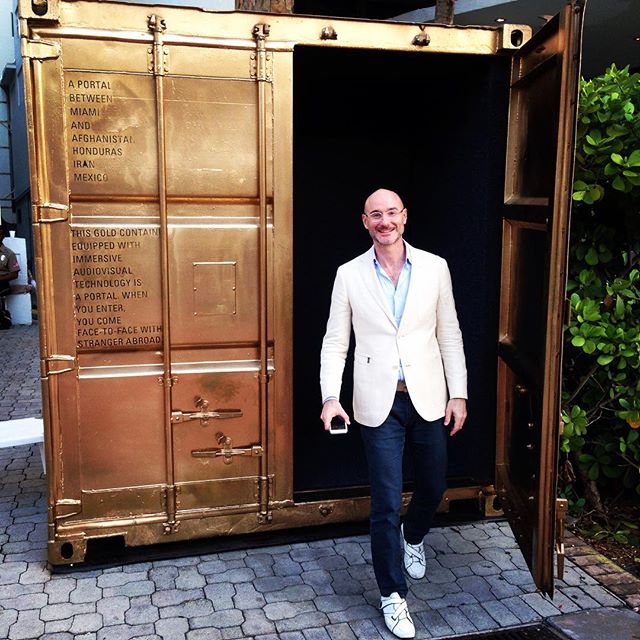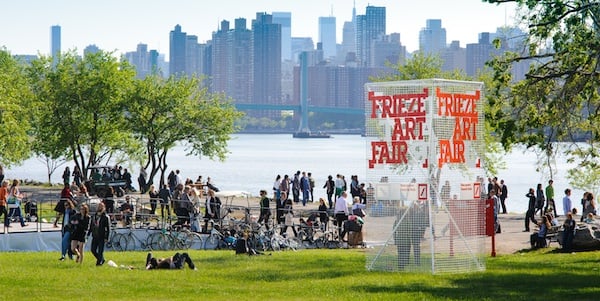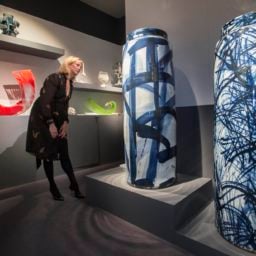Every Monday morning, artnet News brings you The Gray Market. The column decodes important stories from the previous week—and offers unparalleled insight into the inner workings of the art industry in the process.
This week, three industry-specific hot topics worth reviewing…
DOUBLE DIPPING: On Thursday, Victoria Siddall and company notified the industry that they would adjust the schedule for the 2018 edition of Frieze New York, specifically by adding a second VIP preview day to the schedule. The fair will now be guest-list-only on Wednesday, May 2 and Thursday, May 3. The ticket-buying public will be given the succeeding three days to patrol the aisles and wonder how the other 99 percent lives.
Why the shift? An unidentified Frieze rep told ARTnews that “the additional day is designed to welcome the increasing number of collectors, museum professionals, and museum groups that attend the fair each year, providing greater opportunities to engage with the work of today’s leading artists from around the world.”
All of which sounds great if taken at face value. But to me, the change reads like an outward signal of what I’ve been hearing from people around the industry for at least a year: that while Frieze London continues to perform well, Frieze New York has been S-T-R-U-G-G-L-I-N-G.
Although some smaller regional fairs tell a different story, it’s common knowledge by now that sales at leading fairs like Frieze primarily arrive during preview days, when the heavy hitters compete on a closed playing field for first dibs on exhibitors’ premier works. So doubling the number of VIP days strongly suggests that sales at Frieze New York have been lacking—hence the attempt to juice profits for dealers by giving them twice as much alone time with major collectors and institutions.
Yet I’d also argue that we may not even need to know the specifics of Frieze New York’s change(s) to reason that the control panel may be screaming at the fair’s organizers. As a rule, businesses tend not to tinker with formulas that are working well. To use an extreme example, if I were the owner of a successful local carwash, I probably wouldn’t feel compelled to try to artificially jack up demand by importing a massive fleet of pigeons to carpet-bomb local vehicles with bird shit. (Shouts to Nathan For You).
As Nate Freeman pointed out in his ARTnews piece on the format shuffle, doubling up on VIP days represents Frieze New York’s third schedule change in three years. For the 2017 edition, the fair “[shifted] the preview day to Thursday and [cut] back on the days the public could visit the tent on Randall’s Island.” It also dropped booth fees for exhibitors—“a move the organizers themselves called ‘unprecedented’” at the time, to quote my colleague Ben Davis.
Granted, I’m strictly working off of inference here. But the evidence is discouraging regardless of hard facts about profits and losses. If a restaurant guest starts turning purple and clutching his throat, you don’t need a chest X-ray to guess that he might be choking his way toward a toe tag.
On paper, doubling the amount of VIP time counters Sean Kelly’s 2016 judgment of Frieze New York as “incontrovertibly… a one-day fair” in Davis’s piece. And in fairness, I’ll wait until after the 2018 edition to reach any firm conclusions about whether this latest format tweak solved what may be a fundamental problem. But for now it certainly doesn’t quiet the gossip that a fundamental problem exists. [ARTnews]

Benjamin Genocchio has left the Armory.
ARMORY-PIERCING AMMUNITION: Robin Pogrebin of the New York Times reported on Wednesday that multiple women had accused Benjamin Genocchio, the executive director of the Armory Show since January 2016, of sexual harassment. Some of the allegations traced back to Genocchio’s previous posts as editorial director of Louise Blouin Media from 2010-14 and editor-in-chief of artnet News (which, reminder, began syndicating The Gray Market Weekly earlier this year) from 2014-15. And while the accusations are troubling, the Armory’s response to them can nevertheless be read as a legitimate emblem of change.
In total, Pogrebin wrote that “five women who have worked with [Genocchio] over the years told The New York Times that they experienced unwelcome touching by him. In interviews, a total of eight who had worked with him at the Armory Show, Artnet [sic], and Louise Blouin Media said he made sexually inappropriate comments to them, and an additional 11 people said they had observed or knew about Mr. Genocchio making these comments, often in the workplace.”
But since straightforward quantification has starkly illuminated the degree of power imbalance between genders in the industry before, I think it’s worthwhile to assess this latest development by highlighting a big fat zero. That’s the number of full workdays Armory leadership waited before removing Genocchio as executive director once Pogrebin’s story broke. (ARTnews reported that he had been replaced by deputy director Nicole Berry at 3:27 pm ET last Wednesday, or almost exactly four hours after @nytimesarts first tweeted out the story.)
This is not to suggest that we’ve broken through the ogling glass to a fully enlightened, post-gendered art industry. Some might say that it doesn’t even nullify legitimate questions about past institutional knowledge of, or response to, Genocchio’s alleged actions. (For their parts, Louise Blouin “said that she was unaware of such behavior” during Genocchio’s tenure with her organization, per Pogrebin; artnet released a statement in its defense on the day of his ouster; and the Armory Show revealed that outside counsel had ruled that “Genocchio’s conduct [there] did not rise to the level of sexual harassment” after complaints spurred an investigation in spring 2017.)
However, the velocity with which the Armory dismissed Genocchio suggests that the tide is indeed turning—both in the real world and in the art world. We can still debate whether the gravitational pull owes more to genuine concern about workplace culture/common decency or, alternatively, pure survival instinct once accusations hit the public eye. Whatever your answer to that deeper question, though, it doesn’t change the new direction the waves appear to be breaking.

Snapchat’s collaboration with Jeff Koons. Screenshot courtesy of Jonah Grant via Snapchat.
SNAP DECISIONS: Finally this week, an unglamorous follow-up to try to reorient our perspective on what matters in art and tech.
Early last month, many of us in the industry went bananas over Snapchat’s announcement of an augmented-reality collaboration with orb-master Jeff Koons. Snap CEO Evan Spiegel described the project—or more specifically, the Lens technology it harnesses—as “an example of the way Snapchat is trying to remove friction from the creative process.”
However, based on what I heard and saw, Claire Voon of Hyperallergic channeled much of the art-world zeitgeist when she concluded that “Jeff Koons in augmented reality… sounds like the most unnecessary experience ever. Also, definitely the least exciting.”
Street artist Sebastien Errazuriz even generated a mainstream publicity moment by partnering with Cross Lab Studio to create a “vandalized” version of Koons’s AR balloon dog, as a way to ask whether corporations should “be allowed to place whatever content they choose over our digital public space.”
At the time, though, I wrote about how the project may have been motivated more by Snap’s increasingly desperate desire to juice ad revenues rather than lubricate creativity. And about four weeks later, we just learned that the startup as a whole is still spewing blood like a sliced artery—a situation that could kill the whole discussion about Snap X Koons before it climbs any further out of the crib.
After a disastrous quarterly-earnings call last Wednesday, Snap shares nose-dived to close the week at $12.77, or about 25 percent below their $17 lPO last spring. Worse, the company has been trading south of that IPO price for four solid months, or nearly half its lifetime on the New York Stock Exchange.
More than Snap’s missed targets on growth and revenue, or its $40 million loss on unsold pairs of its AR glasses, what seems to have spooked investors so severely was Spiegel’s announcement that he and his team are overhauling the app from the ground up––even as he acknowledged that they “don’t yet know how the behavior of [Snap’s] community will change” as a result. Nitasha Tiku of WIRED magazine wrote that “the redesign sounds so much like conventional social media that one analyst asked if Snap should consider adding a news feed.”
None of this puts to bed the questions raised about potential brand dominance of the nascent augmented-reality and virtual-reality art spaces. In fact, I’d argue that Snap’s possible march toward the grave means that we should pay MORE attention to the rest of the field, not less.
Notably, Facebook quietly introduced its own augmented-reality art initiative in September. As far as I can tell, we in the art media (myself included) barely noticed––at least in comparison to the amount of coverage and conversation spent on Snap’s partnership with Koons.
Remember, Mark Zuckerberg has a history of wounding Snap with its own weaponry. So any of us looking for the future of art and tech might be much better served if we shifted our focus to the company turning a Gatling gun on nearly every competitor rather than the one grasping for blue-chip collabs while it keeps sinking into quicksand. [WIRED]
That’s all for this edition. Til next time, remember: The bigger they are, the harder they (sometimes) fall.
Follow Artnet News on Facebook:
Want to stay ahead of the art world? Subscribe to our newsletter to get the breaking news, eye-opening interviews, and incisive critical takes that drive the conversation forward.










